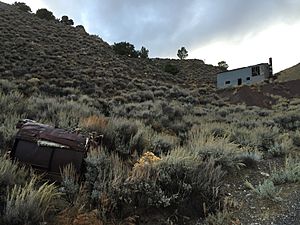El Dorado Canyon (Nevada) facts for kids
Quick facts for kids El Dorado Canyon |
|
|---|---|

Abandoned mining buildings in El Dorado Canyon, at about 5,620 feet (1,710 m) on the western slopes of Star Peak, Nevada
|
|
| Location | U.S. Highway 95 near Nelson, Nevada |
| Reference no. | 6 |
El Dorado Canyon is a famous canyon in southern Clark County, Nevada. It's known for its rich silver and gold mines.
Captain George Alonzo Johnson, who ran steamboats, named the canyon in 1857. This was after gold and silver were found there. The canyon's water flows into the Colorado River. This happens near where Nelson's Landing used to be.
The town of Nelson is located at the top part of the canyon. Midway down the canyon, you can find Eldorado Canyon Mine Tours. They operate at the Techatticup Mine. This mine is one of the oldest and most successful in the area.
Contents
A Look Back: El Dorado Canyon's Story
People started looking for valuable minerals, or 'prospecting,' in El Dorado Canyon around 1857. In April 1861, as the American Civil War began, exciting news spread. John Thomas Moss and others had found silver, gold, and copper in the canyon.
At that time, the canyon was part of New Mexico Territory, which later became Nevada. It was on the west side of the Colorado River. The canyon was about 65 miles (104.6 km) above Fort Mohave. This was considered the furthest point boats could travel up the river.
Captain George A. Johnson offered to supply the mines with his steamboats. This was cheaper than bringing supplies across the Mohave Desert from Los Angeles. That fall, many miners rushed to the canyon. They came because of the new discoveries in the Colorado Mining District. By 1864, this area was also called the Eldorado Canyon District.
Mining Camps and Towns
Over the years, several mining camps were built in the canyon. At first, San Juan, also called Upper Camp, was at the top of the canyon. It was miles from the river, near where Nelson is today.
Midway down the canyon, near the Techatticup Mine, were Alturas and Louisville. At the very end of the canyon, where it met the river, was the boat landing of Colorado City.
During the American Civil War, three new mining camps grew in the middle of the canyon. In 1862, Lucky Jim Camp was formed. It was along Eldorado Canyon, above January Wash, south of the Techatticup Mine. Lucky Jim Camp was home to miners who supported the Confederate side. About a mile (1.6 km) up the canyon was Buster Falls. This camp had miners who supported the Union side.
New Ways to Mine
In late 1863, Colonel John R. Vineyard built the first ten-stamp mill in the canyon. He was a California State Senator for Los Angeles at the time. His mill was on the north side of the canyon, just below Lucky Jim Camp. This area soon became El Dorado City.
Vineyard's mill used parts from old mills in California. It processed the ore right there in the canyon. This saved a lot of money because miners no longer had to ship their ore to San Francisco for processing. It cut their costs in half! George Alonzo Johnson's steamboat company lost business because of this. They made fewer trips to the canyon and raised their prices for freight.
Post Office and Army Outpost
From 1865 to 1867, El Dorado Canyon had its own post office. At that time, it was part of Mohave County, Arizona Territory.
In 1867, the U.S. Army set up Camp El Dorado. This outpost was at the mouth of El Dorado Canyon. It was there to protect riverboat traffic and miners from attacks. The camp stayed until 1869. From 1870, the mines became active again. Because of this, El Dorado Canyon had another post office from 1879 to 1907. By then, it was in Clark County, Nevada.
The mines in El Dorado Canyon kept producing valuable ore until World War II.
See also
 In Spanish: Cañón El Dorado para niños
In Spanish: Cañón El Dorado para niños

